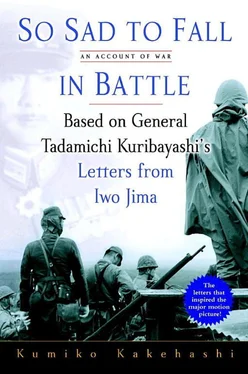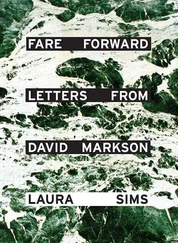Bradley maintains that Kuribayashi had foreseen this response, and that it was precisely for this reason that he opted not to fight and die in a blaze of glory, but to wage a battle of attrition designed to maximize the human toll on the American side.
Bradley’s theory may be correct, but the war subsequently developed in a manner diametrically opposed to Kuribayashi’s hopes. The United States did decide that it did not want any more of its young men to die, but the means it chose to bring the war to a speedy end was to drop the atomic bomb, which killed and maimed Japanese civilians in enormous numbers. This was something that neither Kuribayashi nor the twenty thousand soldiers who fought so unforgivingly could ever have predicted.
August 6, 1945; 5:55 a.m. A single B-29 bomber flew over Iwo Jima, which had already been in U.S. hands for several months. The plane was on its way to the Japanese mainland from Tinian in the Northern Mariana Islands.
“The pilot did not just go straight past, but flew a number of loops around the island,” Bradley told me. “He was paying his respects to the almost seven thousand Americans who lost their lives there.”
The name of the bomber was Enola Gay. Its destination: Hiroshima.
LET’S RETURN TO IWO Jima before the American landing. Kuribayashi’s strategy to hold the island for as long as possible can be distilled into two key elements.
1. To abandon the doctrine of defense at the water’s edge, and instead place the main defensive positions in the interior away from the shoreline.
2. To build underground defensive positions, and make all the soldiers fight from these underground positions.
As Kuribayashi’s plan ran contrary to the Japanese army’s traditional strategy, he was going to need all his strength of will and powers of execution to bring it off.
The “doctrine of defense at the water’s edge”—the doctrine abandoned by Kuribayashi as “ineffective”—involved crushing the enemy on the beaches, just as they were coming ashore. This was one of the Imperial Army’s traditional tactics and had seventy years of history behind it.
An enemy who comes toward the land on boats invariably suffers a temporary loss of offensive strength at the point when it transfers from water to land. The “doctrine of defense at the water’s edge” was all about making a concentrated attack precisely at that moment of opportunity.
Up to that point, this strategy had been fervently believed in, and it was certainly not without advantages.
First of all, the incoming landing craft made an easy target for the defenders on the shore, particularly as they all came in at the same time and were densely packed together. Meanwhile, landing craft had no significant firepower of their own, meaning the defenders had the advantage.
Second, it was possible to methodically pick off the enemy with sniper fire as they came ashore. Since the number of men who could land at any one time was limited, the defenders had the opportunity to eliminate them in sequence. There was no need to face a huge number of the enemy all at the same time.
Third, you could attack the enemy just after they had come ashore and before they were able to deploy any serious firepower. The defending side thus held a significant advantage right after the landing took place, and hitting the enemy hard during this window of opportunity was sure to yield dramatic results.
If you let an enemy with superior fighting power land unmolested, then your chance for victory was as good as lost. To repel an attacking force, the conventional wisdom maintained that you needed to build the key defenses at the water’s edge, where the decisive battle would take place, and also position the bulk of your troops near the shoreline.
This doctrine may have worked well against a poorly equipped enemy on the Chinese front, but in the Pacific islands strategy of the Japanese—whether at Tarawa, Makin, or Saipan—it proved itself a complete and utter failure.
It failed because of American airpower. Before they started their landing operations, the Americans would launch massive aerial bombardments that would obliterate any defensive positions—and installations on the beach had no cover, meaning that they were dangerously easy to find.
Throughout the entire landing operation, intensive support would also be provided by naval barrage and air raids. This meant the overall offensive power of the American forces did not weaken significantly, even at the water’s edge. By contrast, the Japanese forces on Iwo Jima could expect little, if any, support from either sea or air.
The traditional army doctrine of defense at the water’s edge was worthless as long as the Americans enjoyed air and sea supremacy. Kuribayashi was the first to grasp this truth and he made the decision to abandon the old strategy at a very early stage.
The Japanese resistance would quickly collapse if he were to pour vast quantities of men, matériel, and weaponry into the defenses at the shore yet fail to inflict massive damage on the Americans.
Kuribayashi would not allow a spectacular battle at the water’s edge that would culminate in defeat. He felt that his duty was to pin the American forces down on the island for as long as possible while inflicting a maximum number of casualties.
Kuribayashi made up his mind to let the Americans land, and to get his men, hiding like moles in their underground defensive installations, to wage a thoroughgoing battle of resistance.
WHEN KURIBAYASHI ARRIVED on the island on June 8, defenses were already being built near the shore according to the standard water’s-edge doctrine. By June 20, after inspecting every part of the island on foot and examining its topography and geology, Kuribayashi had made up his mind to jettison the traditional strategy and switch to a defense in depth. This, it should be noted, predated the fall of Saipan.
“Defense in depth” meant placing the main defenses at some distance back from the beach and giving up on the idea of making a general counterattack on the enemy immediately after they had landed. Moving the main defenses back from the shoreline meant bringing all the hard work of the soldiers who had been building installations at the water’s edge to nothing, while the officers in charge of the construction efforts were predictably indignant. But Kuribayashi’s resolve held firm.
Colonel Atsuchi Kanehiko was in charge of the “I Detachment,” Iwo Jima’s permanent garrison until the arrival of the 109th Division under Kuribayashi. Atsuchi issued orders for the construction of new defensive positions in the interior on June 23, after receiving Kuribayashi’s new battle policy.
I Detachment Order
1. I Detachment shall temporarily halt the construction of defenses at the water’s edge and will construct defenses in the interior.
2. Every infantry battalion will construct defensive positions in the region shown on the attached map.
3. The artillery battalions will construct positions near Mount Ôsaka and near Minami Buraku, and on the north side of Mount Suribachi in order to cover No. 1 Airfield.
4. The 15th Fortifications Engineer Battalion will work with the infantry and artillery battalions to build the defenses.
5. No. 1 Company of the 9th Independent Engineer Regiment will build the command center for the Division and the command center for the Brigade.
6. The key parts of the defenses listed above must be finished by the end of June.
7. I am in Motoyama Corps Headquarters.
Commander of I Detachment Colonel Atsuchi Kanehiko
The order calls a halt to the building of defensive positions on the shoreline, and states that the interior defenses—or at least the framework for them—should be built quickly.
Читать дальше












